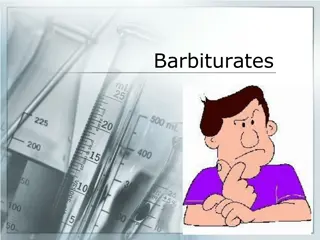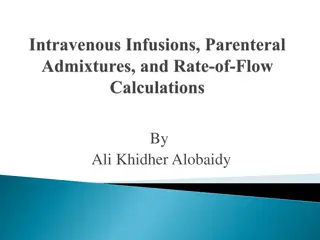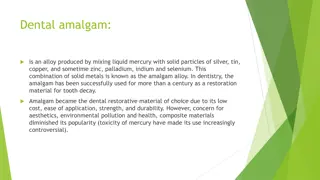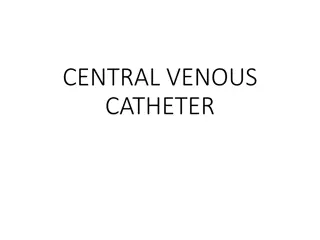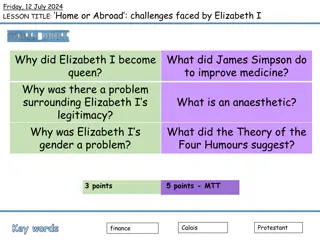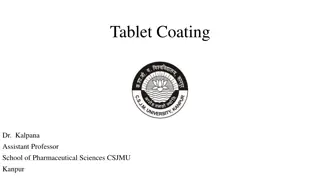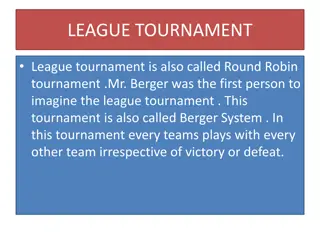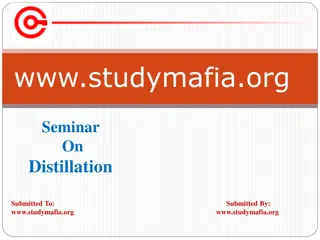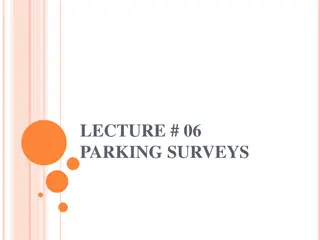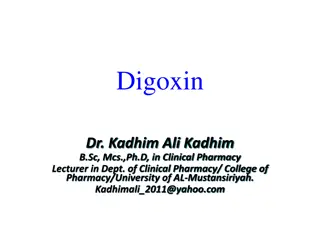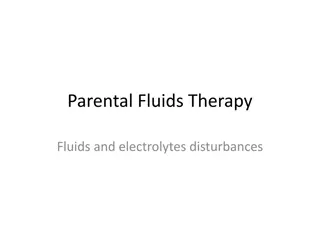Intravenous Anaesthetics and Barbiturates: Usage, Advantages, and Disadvantages
Intravenous anaesthetics, including barbiturates and non-barbiturates, offer advantages such as easy induction and smooth recovery but come with drawbacks like lack of control over anaesthesia level and contraindications in certain conditions. Barbiturates, derived from melonyl urea, are classified based on duration of action and exhibit structure-activity relationships affecting CNS depressant effects.
Download Presentation

Please find below an Image/Link to download the presentation.
The content on the website is provided AS IS for your information and personal use only. It may not be sold, licensed, or shared on other websites without obtaining consent from the author. Download presentation by click this link. If you encounter any issues during the download, it is possible that the publisher has removed the file from their server.
E N D
Presentation Transcript
Intravenous Anaesthetics Dr.Kumari Anjana Assistant Professor Deptt. of Veterinary Pharmacology & Toxicology Bihar Veterinary College, Bihar Animal Sciences University, Patna
INTRAVENOUS ANESTHETICS Barbiturates Anaesthetics- Thiopentone, Thiamylal, Thialbarbitone, Methohexitone and Pentobarbitone Non BarbituratesAnaesthetics - 1. Phenol derivatives- propofol 2. Imidazole derivatives- etomidate and metomidate 3. Steroidal anesthetics- saffan (alphaxalone-alphadolone) 4. Chloral derivatives- chloral hydrates. 5. Benzodiazepines- midazolam and diazepam. 6. Opioid and neurolept analgesics-fentanyl, fentanyl- droperidol combination. 7. Miscellaneous anesthetics- chloralose and urethane.
Advantages Easy, rapid and smooth induction of anaesthesia. Smooth recovery with no complications as seen in inhalational anaesthesia. Vomiting absent during induction. No interference in operations of head region. Minimum equipment is required. Can be used with thermocautery and diathermy. Respiratory complications are not aggravated. Surgeon alone can manage anaesthesia and perform surgery.
Disadvantages Level of anaesthesia not readily controllable. No adequate skeletal muscle relaxation. Contraindicated in hepatic and renal diseases. Unsuitable (barbiturates) for caesarean section (depression of foetal respiration).
Barbiturates Derivatives of melonyl urea. A condensation product of urea and malonic acid. Synthesized by-Conrad and Gutzeit in 1882. Fisher and Von Mering prepared diethyl barbituric acid and discovered its hypnotic activity. They named it as Veronal from the Latin word vera (true) having real hypnotic effect. Baeyer named malonylurea as barbituric acid, which formed the key molecule for a series of hypnotics.
Barbiturates Classification Based on duration of action: Long acting-(4-6 hr) - Barbitone, Phenobarbitone Intermediate acting (2-4 hr) - Pentobarbitone, Butobarbitone Short acting (1-2 hr) - Secobarbitone Ultra Short acting (20-40 min.) Thiopentone, Thiamylal
Structure activity relationship Barbituric acid itself has no CNS depressant effect. Substitution of alkyl, allyl groups at carbon 5, on its structure results in sedative-hypnotic-anaesthetic effect. Short chain substitution at R1 and R2 resists oxidation results in compounds having long duration of action. Long chain substitution at R1 and R2 promotes oxidation short acting compounds.
S.A.R. contd Replacement of carbonyl oxygen at C2 by sulphur atom makes the compounds highly vulnerable to oxidative metabolism rendering the compounds very short acting. Replacement of carbonyl oxygen at C2 by an HN= group (guanidine derivatives) destroys CNS depressant activity. Substitution at C5 should not be less than 4 and not more than 8 for optimal CNS depression. Substitution at C5 with long chain having more than 9 carbon atoms makes the compound convulsant.
MOA of Barbiturates Barbiturates appear to act primarily at the GABA:BZD receptor Cl- Channel complex and potentiate GABAergic inhibition by increasing the lifetime of Cl- Channel opening induced by GABA. They do not bind to the BZD receptor, but bind to another site (probably the picrotoxin) on same macromolecular complex to exert the GABA facilitatory action. The barbiturate site appears to be located on or subunit. They also enhance BZD binding to its receptor.
MOA of Barbiturates contd At high concentrations, barbiturates directly increase Cl- conductance (GABA- mimetic action; contrast BZD which have only GABA facilitatory action) and inhibit Ca++ dependent release of neurotransmitter. In addition they depress glutamate induced neuronal depolarization through AMPA receptors. At very high concentrations, barbiturates depress voltage sensitive of Na+ and K+ channels.
Fig: GABA Receptor chloride channel complex Fig: GABA Receptor chloride channel complex. (linear view) Fig: GABA Receptor (front view)
Drugs affecting GABAA receptor Cl- Channel complex GABA: Endogenous agonist at GABAA receptor promote Cl- influx Mucimol: agonist at GABAA site Bicuculline: competitive antagonist at GABAA receptor Picrotoxin: Blocks Cl- Channel noncompetitively; acts on picrotoxin sensitive site
Drugs affecting GABAA receptor Cl- Channel complex contd Barbiturates: Agonist at an allosteric site; prolong GABA action; open Cl- Channel Alcohol, Inhalational anaesthetics, Propofol: open Cl- Channel directly. Benzodiazepines: Agonist at an allosteric BZD site - facilitate GABA action. carboline : inverse agonist at BZD site- impede GABA action Flumazenil: competitive antagonist atBZD site
THERAPEUTIC USES As Hypnotic & Sedatives Antiepileptic Anticonvulsant As IV general Anesthesia For euthanasia
Major pharmacological effects CNS: Dose dependent depression: mild sedation to deep hypnosis and surgical anaesthesia. Depress both sensory and motor cortex. Respiratory system- slight depression at anaesthetic dose, but respiration failure at high dose. CVS- Rapid IV injection causes sharp, but transient fall in BP. High doses cause prolonged fall in BP (due to vasodilatation and depression of vasomotor centre and heart).
Major pharmacological effects contd Kidney: No significant effect at anaesthetics doses, but high doses causes oliguria/anuria. Uterus and foetus: depress contractions. Also cross placenta causes depression of foetal respiration and death of foetus in utero. Skeletal muscle: No relaxation. Smooth muscle: No significant effect, except in GIT where tone and motility are slightly reduced. parturient uterine
Pharmacokinetics Barbiturates are readily absorbed from GIT and widely distributed in the body. The rate of entry of barbiturates into CNS depends on their lipid solubility. Plasma protein binding varies with compound, thiopentone- 75% phenobarbitone-20%. Barbiturates readily cross placenta and enter foetus and also are secreted in milk.
Pharmacokinetics contd The action of barbiturates are terminated by three process: Redistribution (high lipid soluble thiopentone) Hepatic microsomal metabolism. Renal excretion (drugs with low lipid solubility : long acting) Barbiturates induce hepatic microsomal enzymes increase the rate of their own metabolism and other drugs. Toxicity of barbiturates: High doses death due to respiratory failure followed by cardiac arrest.
Thiopentone (Pentothal/ Intraval) Dog &cat---20-25 mg/kg Pig-10-12mg/kg Calf/goat 15-20 mg/kg Horse- 10mg/kg It is administered as 2.5% solution in small animals and as 5-10% aqueous solution in large animals. dose fast IV then slow IV NOT SC or IM
Pentobarbital sodium As anaesthetic- dog & cat 25-30 mg/kg IV 3.6% solution. Thiamylal sodium Dog 15-20 mg/kg for induction 4%
Chloral hydrate Low margin of safety Poor analgesic effect Satisfactory hypnotic effect 95% - trichloroethanol after oral administration It is used with adequate dilution. Due to antiChE property antagonises the curariform effect. Pre-anaesthetic, sedative and hypnotic in large animal. 10-20gm/adult as 7% solution IV 125-200 ml or 5 gm/45kg orally in one litre of water.
Chlormag anaesthesia As i.v. anaesthesia of large animal : Curariform effect (skeletal muscle relaxation) of MgSO4and hypnotic effect of Chloralhydrate forms a satisfactory anaesthetic combination and has been used for anaesthesia in horses and cattle. Horse and cattle : The combination is used as 300 to 400 ml of Chloralhydrate (12%) and MgSO4 (6%) slow iv Camel : Chloralhydrate (12%) and MgSO4 (12%) is given i.v. So, The solution prepared should be used within an hour.
Chlorpent anaesthesia [Chloral hydrate + MgSO4 + Pentobarbital Sodium] Produces satisfactory anaesthesia without the toxic effect of individual drug. 3% Chloralhydrate + 1.5% mag.sul + 0.66% pentobarbitone Large animal - 500-700 ml slow i.v.



